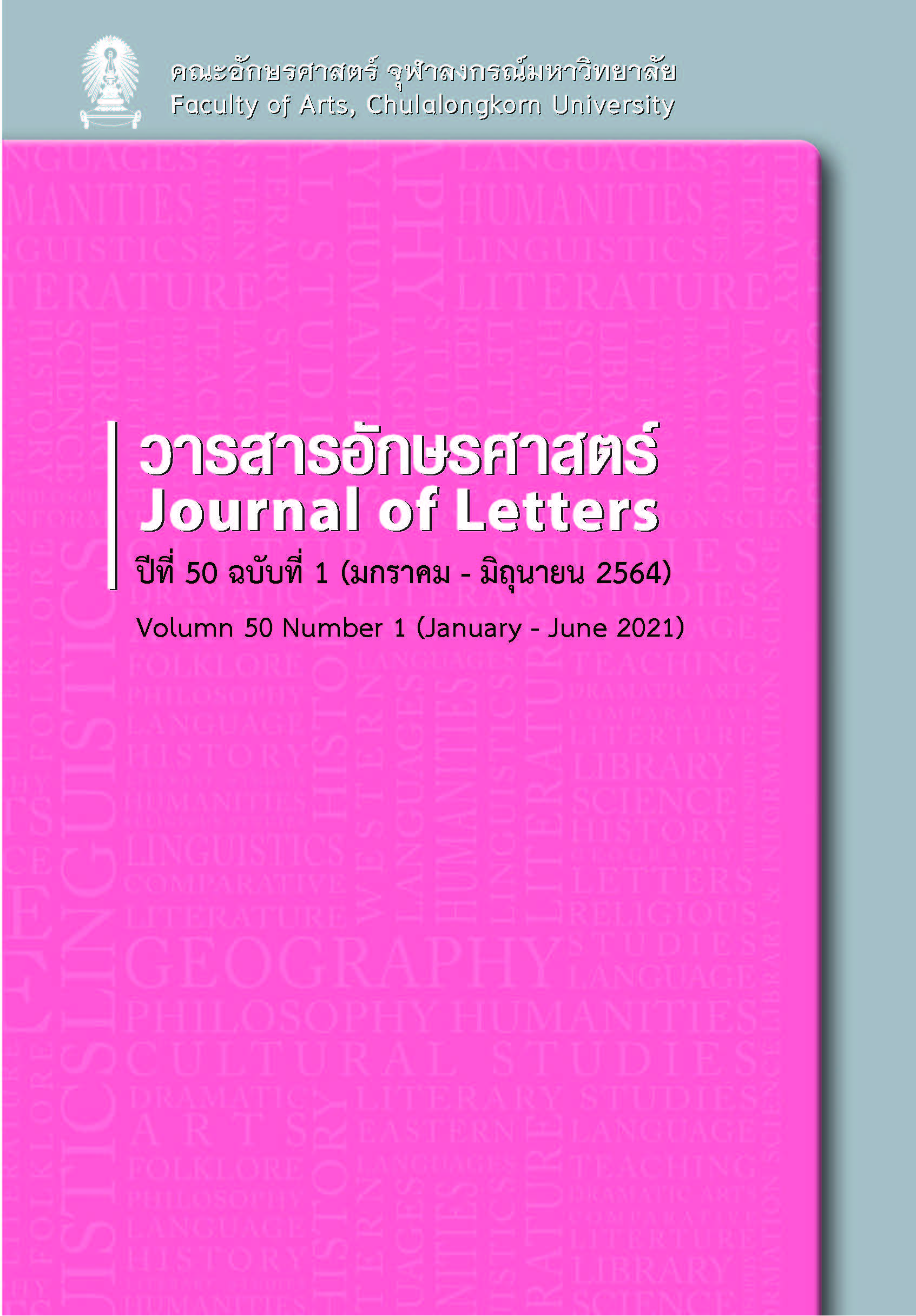คุณค่าสตรีตามแนวคิดปิตาธิปไตยในสังคมศักดินาจีน จากวรรณคดีเรื่อง ความฝันในหอแดง
คำสำคัญ:
คุณค่าสตรี, ปิตาธิปไตย, สังคมศักดินาจีน, ความฝันในหอแดง, วรรณคดีจีนบทคัดย่อ
งานวิจัยนี้มีวัตถุประสงค์เพื่อศึกษาและวิเคราะห์การกำหนดคุณค่าสตรีในวรรณคดีเรื่องความฝันในหอแดง(红楼梦)โดยยึดหลักแนวคิดสามหลักห้าคุณธรรม(三纲五常)และแนวคิดสามคล้อยสี่คุณธรรม(三从四德)มาใช้กำหนดกรอบแนวคิดการวิจัย ขอบเขตข้อมูลการศึกษามาจากความสัมพันธ์ระหว่างตัวละครชายที่เปรียบเสมือนชนชั้นปกครองในตระกูล จย่าและตัวละครหญิงที่มีสถานภาพแตกต่างกัน โดยคัดเลือกความสัมพันธ์ของตัวละคร 3 กลุ่ม ได้แก่ ความสัมพันธ์ระหว่างบิดากับลูกสาว สามีกับภรรยา และเจ้านายกับสาวใช้ วิเคราะห์ข้อมูลที่สะท้อนคุณค่าสตรีที่ปรากฏในบทสนทนาหรือการบรรยายสภาพแวดล้อมของตัวละคร 3 กลุ่ม ผลการศึกษาพบว่าคุณค่าของสตรีในความสัมพันธ์ระหว่างบิดากับลูกสาว บิดาจะเป็นผู้กำหนดให้ลูกสาวเป็นผู้รักษาผลประโยชน์และความมั่นคงของครอบครัว วงศ์ตระกูล คุณค่าของสตรีในความสัมพันธ์ของสามีกับภรรยา พบว่าภรรยาในอุดมคติตามแนวคิดสามคล้อยสี่คุณธรรมจะได้รับความรักและเห็นคุณค่ามากกว่าสตรีที่มีความสามารถ และคุณค่าของสตรีในความสัมพันธ์ของเจ้านายกับสาวใช้ แสดงให้เห็นถึงการให้คุณค่าของสตรีที่เข้าใจความต้องการของผู้เป็นเจ้านายมากกว่าสาวใช้ที่ภายนอกมีกิริยามารยาทเรียบร้อย แต่การกระทำกลับมีวัตถุประสงค์เพื่อหวังผลประโยชน์และเพื่อเอาใจผู้มีอำนาจในครอบครัวให้เห็นถึงคุณค่าและความสำคัญของตน ความสัมพันธ์ทั้งสามกลุ่มนี้สะท้อนให้เห็นถึงสถานภาพและบทบาทของบุรุษตามแนวคิดปิตาธิปไตยที่มีเหนือกว่าสตรีในสังคมศักดินาจีน บุรุษสามารถกำหนดความสำคัญและคุณค่าสตรีให้เป็นไปตามความต้องการและอยู่ภายใต้อำนาจของตน เพื่อช่วยรักษาความมั่นคงของครอบครัว อีกทั้งเป็นภรรยาที่ดีเพื่อสืบทอดวงศ์ตระกูล เห็นได้ชัดว่าสตรีทั้งสามกลุ่มต่างมีชะตาชีวิตที่ถูกตีกรอบจารีตทางสังคมเหมือนกัน ส่งผลให้ได้รับการกำหนดคุณค่าจากบุรุษเพียงเพื่อวงศ์ตระกูลและเพื่อตอบสนองความต้องการของผู้อื่นเท่านั้น
เอกสารอ้างอิง
ภาษาไทย
Kritaporn Manuratanawong, & Suree Choonharuangdej กฤตพร มานุรัตนวงศ์ และสุรีย์ ชุณหเรืองเดช. 2019. Kansưeksa priapthiap wannakam khamson sattri khong Chin rueang Nǚ Jiè, Nèi Xùn, Nǚ Lúnyǔ, Nǚ fàn Jié lù kap wannakam khamson sattri khong Thai nai laksanadiaokan การศึกษาเปรียบเทียบวรรณกรรมคำสอนสตรีของจีนเรื่อง Nǚ Jiè, Nèi Xùn, Nǚ Lúnyǔ, Nǚ fàn Jié lù กับวรรณกรรมคำสอนสตรีของไทยในลักษณะเดียวกัน [Comparative Study of Chinese Didactic Literature for Women: Nǚ Jiè, Nèi Xùn, Nǚ Lúnyǔ, Nǚ fàn Jié lù and Their Thai Equivalents]. Warasarn Chin witthaya วารสารจีนวิทยา [Journal of Sinology] 13: 148-184.
Naiyapat Athitpat นัยน์พัศ อธิษฐ์พัส. 2015. Khunkha khong sattri nai nawaniyai rueang “Than mai chan” khong Mo Yan คุณค่าของสตรีในนวนิยายเรื่อง “ทัณฑ์ไม้จันทน์” ของมั่วเหยียน [Chinese Women’s Value in the Novel “Sandalwood Death” by Mo Yan]. Warasarn Chin sueksa mahawitthayalai Kasetsart วารสารจีนศึกษา มหาวิทยาลัยเกษตรศาสตร [Chinese Studies Journal Kasetsart University] 8(1): 171-195.
_____. 2018. “Khwam yonyaeng haeng seriphap nai nawaniyai rueang khwmfan nai hodaeng lae nawaniyai khong Mo Yan” ความย้อนแย้งแห่งเสรีภาพในนวนิยายเรื่อง ความฝันในหอแดง และนวนิยายของมั่วเหยียน [The paradox of freedom in the Dream of the Red Chamber and Mo Yan’s novels]. Doctoral dissertation, Chulalongkorn University.
Narongkan Rodsub ณรงค์กรรณ รอดทรัพย์. 2012. Pitathipatai: Phapsathon haeng kwam mai samoephak rawang chai ying nai sangkom Asia ปิตาธิปไตย: ภาพสะท้อนแห่งความไม่เสมอภาคระหว่างชายหญิงในสังคมเอเชีย [Patriarchy: The Reflection of the Inequality between Male and Female in Asian Society]. Warasarn wichakan mahawitthayalai Ratchapat Buriram วารสารวิชาการ มหาวิทยาลัยราชภัฏบุรีรัมย์ [Academic Journal of Humanities and Social Sciences Buriram Rajabhat University] 4(2): 30-46.
Puthep Prapagorn ภูเทพ ประภากร. 2021. Khwamfan nai hodaeng: Phapsathon sathanaphap lae botbat khong sattri Chin nai sangkhom sakdina ความฝันในหอแดง: ภาพสะท้อนสถานภาพและบทบาทของสตรีจีนในสังคมศักดินา [The Dream of the Red Chamber: The Status Reflection and the Role of Chinese Women in Feudal Society]. Warasarn wichai Ratchapat Krungkao วารสารวิจัยราชภัฏกรุงเก่า [ARU Research Journal] 8(1): 97-110.
Qiu, Sulin. ชิว, ซูหลุน. 2008. Naeokhit lak amata wannakhadi Chin khwamfan nai hodaeng แนวคิดหลักอมตะวรรณคดีจีน ความฝันในหอแดง [The Main Concept of Dream of the Red Chamber]. Warasarn Chin witthaya วารสารจีนวิทยา [Journal of Sinology] 2: 50-60.
Ratirat Kunjaetong, & Kanokporn Numtong รติรัตน์ กุญแจทอง และกนกพร นุ่มทอง. 2016. Tuean ying: Wannakhadi sorn satri thi praphan khuen phaitai watthanatham khongchue เตือนหญิง: วรรณกรรมสอนสตรีที่ประพันธ์ขึ้นภายใต้วัฒนธรรมขงจื๊อ [The Women's Admonitions: Female Didactic Literature under the Influence of Confucian Culture]. Warasarn Chin sueksa mahawitthayalai Kasetsart วารสารจีนศึกษามหาวิทยาลัยเกษตรศาสตร์ [Chinese Studies Journal Kasetsart University] 8(1): 171-195.
Sayumporn Chanthasithiporn สยุมพร ฉันทสิทธิพร. 2018. Lak khwamsamphan ha prakan lae lak banthatthan sam mummong khong lak chariyatham kap kanraksa sathiaraphap khong sangkhom Chin หลักความสัมพันธ์ห้าประการและหลักบรรทัดฐานสาม มุมมองของหลักจริยธรรมกับการรักษาเสถียรภาพของสังคมจีน [The Five Relationships, The Three Mainstays, Viewpoint from Ethics and The Stability of Chinese Society]. Warasarn MJR sangkomsat paritat วารสาร มจร สังคมศาสตร์ปริทรรศน์ [Journal of MCU Social Science Review] 7(2): 247-261.
Thanat Suwattanamahat ธนัสถ์ สุวัฒนมหาตม์. 2012. Miao Yu: Nuengnai sipsong daruni haeng Jinling nai khwamkhit khong Cao Xueqin เมี่ยวอี้ว์: หนึ่งในสิบสองดรุณีแห่งจินหลิงในความคิดของเฉาเสวี่ยฉิน [Miaoyu: One of the Twelve Young Girls of Jinling in Cao Xueqin's mind]. In Het koet nai ratchawong Ching เหตุเกิดในราชวงศ์ชิง [The Incident Occurred in the Qing Dynasty], ed. Pakorn Limpanusorn, 158-194. Bangkok: Chuan An.
_____. 2017. Wang Xifeng: Dawrai nai sipsong daruni haeng Jinling หวังซีเฟิ่ง: ดาวร้ายในสิบสองดรุณีแห่งจินหลิง [Wang Xifeng: The Culprit of the Twelve Young Girls of Jinling]. In Dawrai nai prawattisat watthanatham Chin ดาวร้ายในประวัติศาสตร์วัฒนธรรมจีน [The Culprit in the History of Chinese Culture], ed. Pakorn Limpanusorn, 54-105. Bangkok: Chuan An.
ภาษาต่างประเทศ
Cao, L. 曹立波. 2017. Hongloumeng Shi'er Chai 红楼梦十二钗 [The Twelve Hairpins of a Dream of Red Mansions]. Beijing: Renmin Wenxue Press.
Cao, X., & Gao, E. 曹雪芹, & 高鹗. 2019. Hongloumeng红楼梦 [The Dream of the Red Chamber]. Changchun: Shidai wenyi Press.
Duan, J. 段丽江. 2019. Hongxue Yanjiu Lunbian红学研究论辩 [Debate on Redology Research]. Shenyang: Liaoning Renmin Press.
He, Y. 何莹. 2011. You Jiafu “Sichun” Xingxiang Yiyun kan Hongloumeng de Sixiang yu Yishu由贾府. “四春”形象意蕴看《红楼梦》的思想与艺术 [On the Thought and Art of Dream of Red Mansion from the Meaning of the Images of the Four Sisters of the Jias]. Changchun Shifan Daxue Xuebao 长春师范大学学报(人文社会科学版)[Journal of Changchun Normal University (Humanities and Social Sciences)] 30(2): 84-88.
Li, X. 李庆信.1997. Hongloumeng Xiangzheng Xingtailun《红楼梦》象征形态论 [Analysis of the Appearance of the Symbols that Appeared in Honglou Meng]. Hongloumeng Xuekan红楼梦学刊 [Journal of A Dream of Red Mansions] 4: 75-86.
Wang, Sh., & Li, Y. 王士超, & 李永田. 2003. Hongloumeng Shici Jianshang 红楼梦诗词鉴赏 [Appreciation of Poems of a Dream of Red Mansions]. Beijing: Beijing Press.
Zhang, Ch. 张琛. 2012. Hongloumeng zhong hua de xiangzheng yiyi he beiju yiwei《红楼梦》中花的象征意义和悲剧意味 [The Symbolic Meaning and Tragic Meaning of Flowers in A Dream of Red Mansions]. Cangzhou Shifan Xueyuan Xuebao 沧州师范学院学报 [Journal of Cangzhou Normal University] 28(2): 33-37.
Zhang, Y., & Jin, Sh. 张英, & 金舒年. 2008. Zhongguo Yuyan Wenhua Jiangjiu 中国语言文化讲究 [Lectures of Chinese Language and Culture]. Beijing: Beijing University Press.
ดาวน์โหลด
เผยแพร่แล้ว
รูปแบบการอ้างอิง
ฉบับ
ประเภทบทความ
สัญญาอนุญาต
การป้องกันปัญหาด้านลิขสิทธิ์และการคัดลอกผลงาน
ผู้เขียนบทความมีหน้าที่ในการขออนุญาตใช้วัสดุที่มีลิขสิทธิ์คุ้มครองจากเจ้าของลิขสิทธิ์ ผู้เขียนบทความมีความรับผิดชอบที่จะต้องปฏิบัติตามกฎหมายในการคัดลอกและทำสำเนาวัสดุที่มีลิขสิทธิ์อย่างเคร่งครัด การคัดลอกข้อความและการกล่าวพาดพิงถึงเนื้อหาจากวัสดุตีพิมพ์อื่น ต้องมีการอ้างอิงแหล่งที่มากำกับและระบุแหล่งที่มาให้ชัดเจนในส่วนบรรณานุกรม การคัดลอกข้อความหรือเนื้อหาจากแหล่งอื่นโดยไม่มีการอ้างอิงถือเป็นการละเมิดจริยธรรมทางวิชาการที่ร้ายแรง และเข้าข่ายการละเมิดลิขสิทธิ์ตามพระราชบัญญัติลิขสิทธิ์ พ.ศ. 2537 หากมีการฟ้องร้องดำเนินคดีใด ๆ เกิดขึ้น ผู้เขียนบทความมีความรับผิดชอบทางกฎหมายแต่เพียงผู้เดียว



